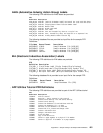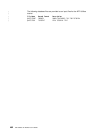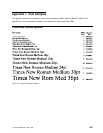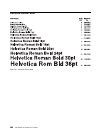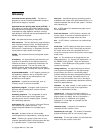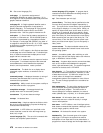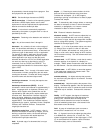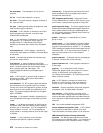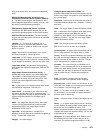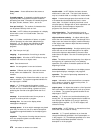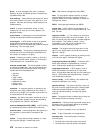
Glossary
advanced function printing (AFP). The ability of
programs to use the all-points-addressable concept to
print text and images on a printer.
advanced function printing data stream (AFPDS). In
AFP support, the printer data stream used for printing
advanced function printing data. The AFPDS includes
composed text, page segments, electronic overlays,
form definitions, and fonts that are downloaded from the
AS/400 system to the printer.
AFP. See
advanced function printing (AFP)
.
AFP resources. The form definitions, page definitions,
fonts, overlays (electronic forms), and page segments
(graphic images). With PrintManager, resources can
either exist in a system library, or be placed inline with
a print job as the job is written to the spool.
AFPDS. See
advanced function printing data stream
(AFPDS)
.
all authority. An object authority that allows the user
to perform all operations on the object except those
limited to the owner or controlled by authorization list
management authority. The user can control the
object’s existence, specify the security for the object,
and change the object. Contrast with
exclude authority
.
all-points-addressable. In AFP support, pertaining to
the capability to address, refer to, and position text,
overlays, and images at any defined point on the
printable area of the paper.
application. A particular business task, such as
inventory control or accounts receivable.
application program. A program used to perform a
particular data processing task, such as inventory
control or payroll.
ascending sequence. The arrangement of data in
order from the lowest value to the highest value,
according to the rules for comparing data. Contrast
with
descending sequence
.
authorization list. A list of two or more user IDs and
their authorities for system resources. The
system-recognized identifier for the object type is
*AUTL.
bar code. A pattern of bars of various widths
containing data to be interpreted by a scanning device.
batch. Pertaining to a group of jobs to be run on a
computer sequentially with the same program with little
or no operator action. Contrast with
interactive
.
batch job. A predefined group of processing actions
submitted to the system to be performed with little or no
interaction between the user and the system. Contrast
with
interactive job
.
bin. In AFP support, the standard-size paper source
on the IBM 3820.
block edit function. In AFP Utilities, a function that
moves, copies, or removes all elements defined in a
specified scope on the image area at one time.
box. In AFP Utilities, a continuous line constructing a
rectangle.
break field. In AFP Utilities, the field which causes a
page break. When the Print Format Utility encounters
the record whose value of the specified field in the
record are not equal to that of the previous record, page
break occurs.
byte. (1) The smallest unit of storage that can be
addressed directly. (2) A group of 8 adjacent bits. In
the EBCDIC coding system, 1 byte can represent a
character. In the double-byte coding system, 2 bytes
represent a character.
change authority. An object authority that allows a
user to perform all operations on the object except
those limited to the owner or controlled by object
existence authority and object management authority.
The user can add, change, and delete entries in an
object, or read the contents of an entry in the object.
Change authority combines object operational authority
and all the data authorities.
character. Any letter, number, or other symbol in the
data character set that is part of the organization,
control, or representation of data.
character set. A group of characters used for a
specific reason; for example, the set of characters the
display station can display, the set of characters a
printer can print, or a particular set of graphic
characters in a code page; for example, the 256
EBCDIC characters.
character string. A sequence of consecutive
characters that are used as a value.
characters per inch (cpi). The number of characters
printed horizontally within an inch across a page.
check digit. The far right number of a self-check field
used to verify the accuracy of the field.
Copyright IBM Corp. 1996, 1998 469



